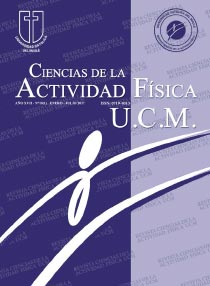Batlle-Gualda, E., Bernabeu, P., Santos, G., & Pascual, E. (2000). Methods of clinical evaluation of rheumatoid arthritis. Revista clínica española, 200, 32.
Batlle-Gualda, E., & Chalmeta-Verdejo, C. (2002). Calidad de vida en la artritis reumatoide. Revista Española de Reumatología Suplementos, 1(1), 9-21.
Bruce, B. & Fries, J.F. (2003). The Stanford Health Assessment Questionnaire: a review of its history, issues, progress, and documentation. Revista Rheumatol, 30; 167-178. doi: 10.1186/1477-7525-1-20
Buiza, C., Navarro, A., Díaz-Orueta, U., González, M. F., Álaba, J., Arriola, E., ... & Yanguas, J. J. (2011). Evaluación breve del estado cognitivo de la demencia en estadios avanzados: resultados preliminares de la validación española del Severe Mini-Mental State Examination. Revista Española de Geriatría y Gerontología, 46(3), 131-138. https://doi.org/10.1016/j.regg.2010.09.006
Carnero-Pardo, C. (2014). ¿Es hora de jubilar al Mini-Mental?. Neurología, 29(8), 473-481. https://doi.org/10.1016/j.nrl.2013.07.003
Colcombe, S.J., Erickson, K.I., Scalf, P.E., Kim, J.S., Prakash, R., McAuley, E., et al. (2006). Aerobic exercise training increases brain volume in aging humans. J Gerontol A Biol Sci Med Sci. 61:1166-70. https://doi.org/10.1093/gerona/61.11.1166
Concha-Cisternas, Y., & Marzuca-Nassr, G. (2016). Criterios de valoración geriátrica integral en adultos mayores auto-valentes y en riesgo de dependencia en centros de atención primaria en Chile. Revista de estudiosos en movimiento, 3(1), 31–41.
Concha-Cisternas, Y.F., Guzman-Muñoz, E.E., & Marzuca-Nassr, G.N. (2017). Efectos de un programa de ejercicio físico combinado sobre la capacidad funcional de mujeres mayores sanas en Atención Primaria de Salud. Fisioterapia, 39(5), 195-201. Doi: http://dx.doi.org/10.1016/j.ft.2017.03.002
DeSalvo, K.B., Bloser, N., Reynolds, K., He, J., & Muntner, P. (2006). Mortality pre-diction with a single general self-rated health question. Journal of general internal medicine, 21(3), 267-275. Doi: 10.1111 / j.1525-1497.2005.00291.x
Domínguez-Carrillo, L.G., Arellano-Aguilar, G., & Leos-Zierold, H. (2007). Tiempo unipodal y caídas en el anciano. Cirugia y Cirujanos, 75(2), 107-112.
Graham, D.F., Carty, C.P., Lloyd, D.G. & Barett, R.S. (2015). Biomechanical pre-dictors of maximal balance recovery performance amongst community-dwelling older adults. Experimental Gerontology, 66(1), 39- 46. Doi:10.1016/j.exger.2015.04.006
Granacher, U., Lacroix, A., Muehlbauer, T., Roettger, K. & Gollhofer, A. (2013). Effects of core instability strength training on trunk muscle strength, spinal mobility, Dynamic balance and functional mobility in older adults. Geontology, 59(2), 105-113. Doi:10.1159 / 000343152
González-Román, L., Bagur-Calafat, C., Urrútia-Cuchí, G., & Garrido-Pedrosa, J. (2016). Interventions based on exercise and physical environment for preenting falls in cognitively impaired older people living in long-term care facilities: a systematic review and meta-analysis. Revista Española de Geriatría y Gerontología, 51(2), 96-111. Doi: 10.1016 / j.regg.2015.12.002
Heyn, P., Abreu, B. C., & Ottenbacher, K. J. (2004). The effects of exercise training on elderly persons with cognitive impairment and dementia: a meta-analysis. Archives of physical medicine and rehabilitation, 85(10), 1694-1704. Doi: http://dx.doi.org/10.1016/j.apmr.2004.03.019
Hilliard, M.J., Martinez, K.M., Janssen, I., Edwards, B., Mille, M.L., Zhang, Y., & Rogers, M.W. (2008). Lateral balance factors predict future falls in community-living older adults. Archives of physical medicine and rehabilitation, 89(9), 1708-1713. Doi: 10.1016 / j.apmr.2008.01.023
Instituto Nacional de Estadística (2003). Catastro de población adulta mayor: Adultos mayores por regiones, comunas y porcentajes. Recuperado de http://www.ine.cl/canales/chile_estadistico/esta-disticas_sociales_culturales/adultos-mayores/pdf/mayorescenso2002.pdf
Izquierdo, M., Casas-Herrero, A., Martínez-Velilla, N., Alonso-Bouzón, C., & Rodríguez-Mañas, L. (2016). Un ejemplo de cooperación para la implementación de programas relacionados con el desarrollo de ejercicio en ancianos frágiles: Programa Europeo Erasmus+«Vivifrail». Revista Española de Geriatría y Gerontología, 52(2), 110-111. Doi: 10.1016/j.regg.2016.03.004
Franco-Martín M., Parra-Vidales E., González-Palau F., Bernate-Navarro M, Solis A. (2013). Influencia del ejercicio físico en la prevención del deteriorocognitivo en las personas mayores: revisión sistemática. Rev Neurol, 56(11): 545-554
Kuosmanen, K., Rovio, S., Kivipelto, M., Tuomilehto, J., Nissinen, A., & Kulmala, J. (2016). Determinants of self-rated health and self-rated physical fitness in middle and old age. European Journal of Mental Health 11(1), 128–143.
Jones, C.J., & Rikli, R.E. (2002). Measuring functional. The Journal on active aging, 1, 24-30.
López, M.D., Zamarrón, M.D., & Fernández-Ballesteros, R. (2011). Asociación entre la realización de ejercicio e indicadores de funcionamiento físico y cognitivo. Comparativa de resultados en función de la edad. Revista Española de Geriatría y Gerontología, 46(1), 15-20. Doi: 10.1016/j.regg.2010.06.002
Ministerio de Salud [MINSAL]. (2015). Orientación Técnica Programa Más Adultos Mayores Autovalentes. División de Atención Primaria Subsecretaría de Redes Asistenciales Ministerio de Salud. Recuperado de http://ssmaule.redsalud.gob.cl/index.php/component/jdownloads/send/118-programa-mas-am-autovalentes/394-orientacion-tec-nica-programa-mas-adultos-mayores-autovalentes?option=com_jdownloads
MINSAL. Manual de Aplicación del Examen de Medicina Preventiva del Adulto Mayor. (2001). Escuela de Kinesiología, Facultad de Salud, Universidad Santo Tomás, Chile. http://web.minsal.cl/portal/url/item/ab1f81f43e-f0c2a6e04001011e011907.pdf Ministerio de Salud Chile; [updated cited 2017 09-09-2017]; Available from: http://web.minsal.cl/portal/url/item/ab-1f81f43ef0c2a6e04001011e011907.pdf
Pincus, T., Summey, J. A., Soraci, S. A., Wallston, K. A., & Hummon, N. P. (1983). Assessment of patient satisfaction in activities of daily living using a modified Stanford Health Assessment Questionnaire. Arthritis & Rheumatology, 26(11), 1346-1353. Doi: 10.1002 / art.1780261107
Reigal, R.E. y Hernández, A. (2014). Efectos de un programa cognitivo-motriz sobre la función ejecutiva en una muestra de personas mayores. Revista Internacional de Ciencias del Deporte, 37(10), 206-220. Recuperado de: http://www.redalyc.org/pdf/710/71031192004.pdf
Ponds, R., Boxtel, M.P., Jolles J. (2000). Age-related changes in subjective cognitive functioning. Educat Gerontol. 26:67–81. http://dx.doi.org/10.1080/036012700267402
Smith, J.C., Nielson, K.A., Woodard, J.L., Seidenberg, M., & Rao, S.M. (2013). Physical Activity and Brain Function in Older Adults at Increased Risk for Alzheimer’s Disease. Brain Sciences, 3(1), 54-83. Doi: 10.3390/brains-ci3010054
Spirduso, W.W., Francis, K.L., MacRae, P.G., 2005. Physical Function of Older Adults. In: Spirduso, W.W. (Ed.), Physical Dimensions of Aging. Human Kinetics, Champaign, IL, pp. 261–286.
United Nations. (2001). World Population Ageing: 1950-2050. Department of Economic and Social Affairs: Population Division. Recuperado de http://www.un.org/esa/population/publica-tions/worldageing19502050/
Van Gelder, B. M., Tijhuis, M. A. R., Kalmijn, S., Giampaoli, S., Nissinen, A., & Kromhout, D. (2004). Physical activity in relation to cognitive decline in elderly men The FINE Study. Neurology, 63(12), 2316-2321.
Vidarte Claros, J. A., Quintero Cruz, M. V., & Herazo Beltrán, Y. (2012). Efectos del ejercicio físico en la condición física funcional y la estabilidad en adultos mayores. Hacia la Promoción de la Salud, 17(2), 79-90. Recuperado de: http://www.redalyc.org/articulo.oa?id=309126826006
Wood, R.H., Reyes, R., Welsch, M.A., Favaloro-Sabatier, J., Sabatier, M., Lee, C.M., ... & Hooper, P.F. (2001). Concurrent cardiovascular and resistance training in healthy older adults. Medicine and science in sports and exercise, 33(10), 1751-1758. Doi: 0195-9131/01/3310-1751


